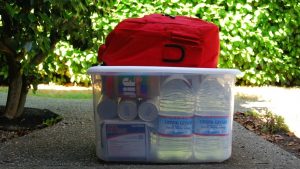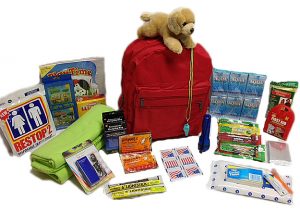Survival. Its not a topic we choose to talk about. Yet no one ever wants to be in a situation when an emergency or tragedy happens and not feel prepared. Yes this also sounds awful to think and prepare for. But sadly its part of life and when you have children or pets you need to have a game plan.
Sometimes wondering where to start is completely overwhelming. When that feeling happens a lot of times people push it to the back burner and say, “I will get it tomorrow.” Tomorrow turns to next week and next week turns into next month and then you never get it done.
There are two different ways to put together a kit. You can easily buy one at Walmart.com, Amazon.com, or the Red Cross sells them. Kits can range anywhere from $65 – $180 depending on what you put in them. But if you are looking to make your own lets walk you through the basics of putting together a survival kit. This list is from The Red Cross which you can also find on there website under Kit List.
At a minimum, you should have the basic supplies listed below:

- Water: one gallon per person, per day (3-day supply for evacuation, 2-week supply for home)
- Food: non-perishable, easy-to-prepare items (3-day supply for evacuation, 2-week supply for home).
- Flashlight Available on the Red Cross Store
- Battery-powered or hand-crank radio (NOAA Weather Radio, if possible) Available on the Red Cross Store
- Extra batteries
- First aid kit Available on the Red Cross Store
- Medications (7-day supply) and medical items
- Multi-purpose tool
- Sanitation and personal hygiene items
- Copies of personal documents (medication list and pertinent medical information, proof of address, deed/lease to home, passports, birth certificates, insurance policies)
- Cell phone with chargers
- Family and emergency contact information
- Extra cash
- Emergency blanket Available on the Red Cross Store
- Map(s) of the area
Consider the needs of all family members and add supplies to your kit:
- Medical supplies (hearing aids with extra batteries, glasses, contact lenses, syringes, etc)
- Baby supplies (bottles, formula, baby food, diapers)
- Games and activities for children
- Pet supplies (collar, leash, ID, food, carrier, bowl)
- Two-way radios
- Extra set of car keys and house keys
- Manual can opener
Additional supplies to keep at home or in your survival kit based on the types of disasters common to your area:
- Whistle
- N95 or surgical masks
- Matches
- Rain gear
- Towels
- Work gloves
- Tools/supplies for securing your home
- Extra clothing, hat and sturdy shoes
- Plastic sheeting
- Duct tape
- Scissors
- Household liquid bleach
- Entertainment items
- Blankets or sleeping bags
Plan a weekend where you either dedicate a couple of hours to putting together a kit or even break it down into two weekends. If you are doing this for your family, have them help you. Explain to your children (age appropriate) why you are doing it so they can also be prepared. You always want to feel secure and prepared in case the worst happens. Having a proper survival kit stored and ready for an emergency is a critical part of keeping you and your family safe during the event of a crisis.

